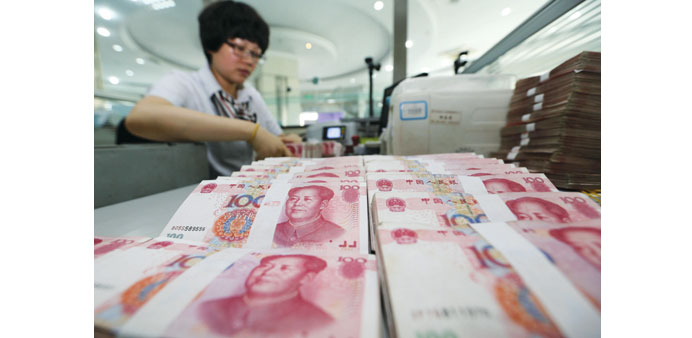A teller counts yuan banknotes in a bank in Lianyungang, China. While International Monetary Fund staff estimate a weighting of 14 to 16%, the market consensus is for 10% because of the currency’s limited usability, according to Mizuho Bank.
Bloomberg
Beijing
The yuan fell towards a three-month low amid concern China will win a smaller weighting in the IMF’s Special Drawing Rights than some analysts predict.
While International Monetary Fund staff estimate a weighting of 14 to 16%, the market consensus is for 10% because of the currency’s limited usability, according to Mizuho Bank. Anything less than that will spark a decline, said Ken Cheung, a Hong Kong-based strategist at the Japanese lender. Many observers are still going by the IMF projection, said Sue Trinh, head of Asia foreign-exchange strategy at Royal Bank of Canada.
“We could see knee-jerk selling if a weight of 10% is announced,” said Hong Kong-based Trinh. “I wouldn’t be surprised if the offshore yuan broke beyond 6.45 a dollar and proceeded to test 6.50 immediately following the SDR announcement, or in one to two weeks. The onshore yuan is entirely dependent on the daily fixing, but it will probably test the weaker end of the trading band.”
The yuan fell 0.07% to 6.3942 a dollar in Shanghai Friday, China Foreign Exchange Trade System prices show. It dropped to 6.3955 on November 23, the lowest since August, and is headed for a fourth weekly decline.
In Hong Kong’s offshore market, the yuan lost 0.05% on Friday and 0.26% from November 20 to 6.4384. The People’s Bank of China cut its daily fixing, which limits the onshore yuan’s moves to 2% on either side, by 0.03% to 6.3915.
The IMF’s executive committee is scheduled to meet tomorrow to decide whether to accept the yuan into the lender’s basket of reserve currencies. Inclusion will spur inflows of as much as $1.1tn in five years, according to Standard Chartered.
Central banks will allocate $770bn to the yuan in the coming six years if the currency gets a 14% share, and $540bn if the figure is 10%, according to Credit Agricole CIB.
At the IMF’s last five-yearly review in 2010, the dollar was granted a weighting of 41.9%, the euro 37.4%, the pound 11.3% and the yen 9.4%.
The ratio is decided based on the country’s exports in terms of goods and services. SDRs, which amounted to about $280bn globally as of September, are claims that can be converted into any of the basket’s currencies.
“A weight below 10% would probably be interpreted as a less significant reserve-currency status for the yuan and less capital inflows to yuan-denominated assets would be implied, putting the currency under pressure,” said Mizuho’s Cheung.
“Investors will likely continue to reduce their yuan exposure ahead of the SDR vote” to avoid such uncertainties, he said.



